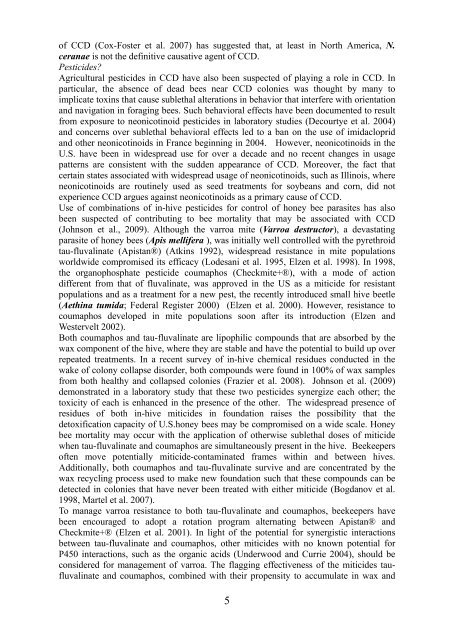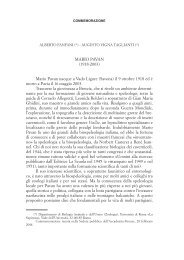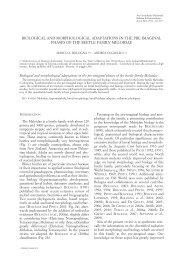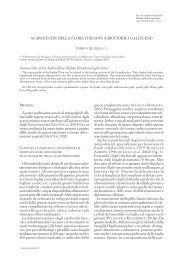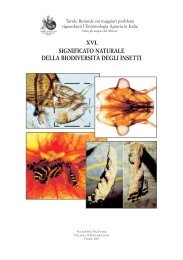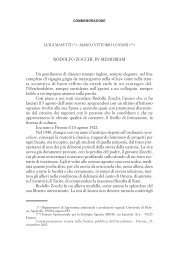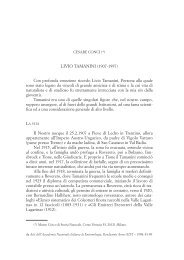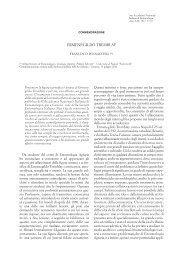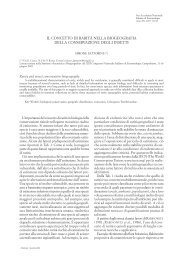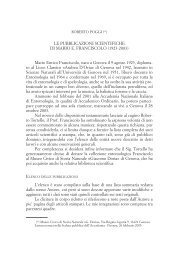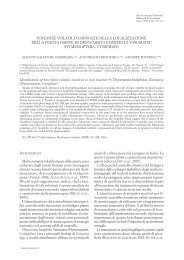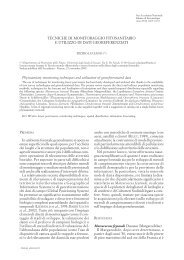XXII CNIE - Accademia nazionale italiana di Entomologia
XXII CNIE - Accademia nazionale italiana di Entomologia
XXII CNIE - Accademia nazionale italiana di Entomologia
You also want an ePaper? Increase the reach of your titles
YUMPU automatically turns print PDFs into web optimized ePapers that Google loves.
of CCD (Cox-Foster et al. 2007) has suggested that, at least in North America, N.<br />
ceranae is not the definitive causative agent of CCD.<br />
Pesticides?<br />
Agricultural pesticides in CCD have also been suspected of playing a role in CCD. In<br />
particular, the absence of dead bees near CCD colonies was thought by many to<br />
implicate toxins that cause sublethal alterations in behavior that interfere with orientation<br />
and navigation in foraging bees. Such behavioral effects have been documented to result<br />
from exposure to neonicotinoid pesticides in laboratory stu<strong>di</strong>es (Decourtye et al. 2004)<br />
and concerns over sublethal behavioral effects led to a ban on the use of imidacloprid<br />
and other neonicotinoids in France beginning in 2004. However, neonicotinoids in the<br />
U.S. have been in widespread use for over a decade and no recent changes in usage<br />
patterns are consistent with the sudden appearance of CCD. Moreover, the fact that<br />
certain states associated with widespread usage of neonicotinoids, such as Illinois, where<br />
neonicotinoids are routinely used as seed treatments for soybeans and corn, <strong>di</strong>d not<br />
experience CCD argues against neonicotinoids as a primary cause of CCD.<br />
Use of combinations of in-hive pesticides for control of honey bee parasites has also<br />
been suspected of contributing to bee mortality that may be associated with CCD<br />
(Johnson et al., 2009). Although the varroa mite (Varroa destructor), a devastating<br />
parasite of honey bees (Apis mellifera ), was initially well controlled with the pyrethroid<br />
tau-fluvalinate (Apistan®) (Atkins 1992), widespread resistance in mite populations<br />
worldwide compromised its efficacy (Lodesani et al. 1995, Elzen et al. 1998). In 1998,<br />
the organophosphate pesticide coumaphos (Checkmite+®), with a mode of action<br />
<strong>di</strong>fferent from that of fluvalinate, was approved in the US as a miticide for resistant<br />
populations and as a treatment for a new pest, the recently introduced small hive beetle<br />
(Aethina tumida; Federal Register 2000) (Elzen et al. 2000). However, resistance to<br />
coumaphos developed in mite populations soon after its introduction (Elzen and<br />
Westervelt 2002).<br />
Both coumaphos and tau-fluvalinate are lipophilic compounds that are absorbed by the<br />
wax component of the hive, where they are stable and have the potential to build up over<br />
repeated treatments. In a recent survey of in-hive chemical residues conducted in the<br />
wake of colony collapse <strong>di</strong>sorder, both compounds were found in 100% of wax samples<br />
from both healthy and collapsed colonies (Frazier et al. 2008). Johnson et al. (2009)<br />
demonstrated in a laboratory study that these two pesticides synergize each other; the<br />
toxicity of each is enhanced in the presence of the other. The widespread presence of<br />
residues of both in-hive miticides in foundation raises the possibility that the<br />
detoxification capacity of U.S.honey bees may be compromised on a wide scale. Honey<br />
bee mortality may occur with the application of otherwise sublethal doses of miticide<br />
when tau-fluvalinate and coumaphos are simultaneously present in the hive. Beekeepers<br />
often move potentially miticide-contaminated frames within and between hives.<br />
Ad<strong>di</strong>tionally, both coumaphos and tau-fluvalinate survive and are concentrated by the<br />
wax recycling process used to make new foundation such that these compounds can be<br />
detected in colonies that have never been treated with either miticide (Bogdanov et al.<br />
1998, Martel et al. 2007).<br />
To manage varroa resistance to both tau-fluvalinate and coumaphos, beekeepers have<br />
been encouraged to adopt a rotation program alternating between Apistan® and<br />
Checkmite+® (Elzen et al. 2001). In light of the potential for synergistic interactions<br />
between tau-fluvalinate and coumaphos, other miticides with no known potential for<br />
P450 interactions, such as the organic acids (Underwood and Currie 2004), should be<br />
considered for management of varroa. The flagging effectiveness of the miticides taufluvalinate<br />
and coumaphos, combined with their propensity to accumulate in wax and<br />
5


